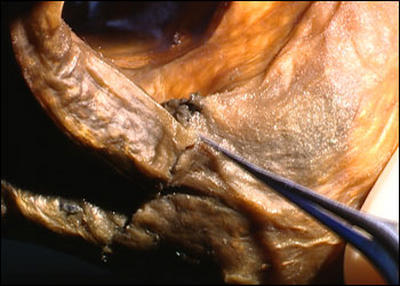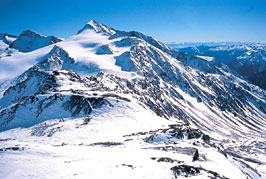|

Noorderlicht Nieuws - Source: VPRO's Noorderlicht

The weapons and clothes from Ítzi contained blood from 4 different persons.
(photo: GHS Schwabsberg).
Below: His right hand showed deep cuts into the strings.
(photo: Brando Quilici Productions/DCI and Discovery Channel)

A new theory has been launched about the death of Ítzi. On the tools of the 5300
years old icemummy traces have been found of four different people, who
probably caused his violent death, according to an Australian biologist. It's
just a pity that he doesn't publicate his theory in a scientific journal.
Ítzi was in a fight; DNA traces reveal the enemies of the icemummy
(August 15, 2003)
Ítzi died in a violent way, according to the Australian biologist Tom Loy.
He states that Ítzi was in fight with at least two people, just before he
died. Loy draws the conclusion after he found the DNA of four different people in
small traces of blood on the weapons and clothes that have been found with Ítzi.
The biologist has enough leads to reconstruct the last moments of Ítzi. He
states his conclusion via Discovery Channel
(augustus/september 2003).

Right: Ítzi in the museum of Bolzano. He lies in a special designed
cooling chamber. There are two identical cold rooms with independent cooling
systems. The mummy lies in one of them at a temperature of -6░C and a relative
air humidity of 98%. There are also a research room and a disinfection place
present.
Visitors can observe the mummy through a small window.
Loy found four traces of blood: two on the remains of an arrow, one on a
knife and one on the back of a cloak that he wore. He thinks that Ítzi wounded
two different people with the arrow. The trace on the back of the cloak probably
comes from a woonded companion of Ítzi, who leaned on his shoulders to stay
upright.
The theory is one in a long line of different theories about his death. Since
the body has been discovered in 1991 scientists fantasize about it in the open.
At this moment most scientists agree that Ítzi didn't die by natural causes
because of the arrowhead in his back.
Loy agrees that that weapon caused Ítzis death. he thinks Ítzi was hit by
an arrow while fighting in a hostile territory. The blood of the enemy was on
his knife.
Ítzi, who died at 46 years and who was about 1.60m high, fled
but eventually died of his wounds. He concludes that by the worthy gear that was
found near his body, suich as an axe and clothes. His enemies had surely taken
these things with them if Ítzi hadn't escaped.

His axe, over 99% copper
The mummie also appeared to have massive injuries, for example a deep cut
until the tendons of his hand. He probably got these injuries during his last
battle.
The newly discovered traces of blood were certainly not the only ones that
Loy found. Some years earlier he wrote in the magazine New Scientist that
the gear of Ítzi contained lots of blood, also on the bow. According the
biologist this worked like a kind of preservative to the bow. Dried blood makes
objects waterproof and therefore prevented the bow from warping. Loy also tested
the blood on mitochondrial DNA. That is DNA which contains valuable information.
Only a little of this kind of DNA is rewuired to identify each human.
Besides, a cel contains often lots more mitochondrial DNA dan
"regular" DNA, which is located in the nucleus of a cel. So human
tissue which is dead for a long period could still contain lots of mitochondrial
DNA, even if the "evidence" has been decayed for a large part.

This is a good method for measuring, according to Peter de Knijff,
head of the Forensic Laboratorium for DNA-investigation of the Universiteit Leiden.
De Knijff trusts the research results of Loy even though very few
laboratories in the world can analyse mummies that are that old. He is only
critical about the way by which the Australian published his research results.
"Of course everyone should consider this for himself, but when one sells
research results to a TV-station then other scientists can't check the results.
Such results should first be publicated, so others can check the data in a
scientific way. It also involves risks, because this way an investigation can
also be rejected. It stroke me that results that are published in a spectaculair
way via Discovery Channel
also often appear to be the largest scientific failures. But that can also be a
coincidence. At least I hope that the research of Loy will eventually become a
scientific publication."
Aschwin Tenfelde
A reconstruction of his last hours
(updated until October 22, 2003)
Discovery Channel continues its research: this time a few scientists show
us their theories about his last hours. All facts point towards a violent death
and therefore the approach is as with a regular murder case:
- what was the murder weapon?
- who was the assasin?
- where did he come from?
Those questions puzzle all, and each answer raises a new question...
Pathologist anatomist Dr. Egarter was there from the start. According
to him Ítzi had a flint knife in his hand when he was first discovered.
Dr. Gostner is a radiologist and he examined the wounds on Ítzis
body:
- there's a cut in his left hand. A wound like this
is common at victims of assaults with a knife. It is a typical defensive
wound: the victim tries to protect its vital organs.

(see photo right)
- on the front of his body are 3 large blue stains
-
there's a cut in his right arm
Besides that, a few bones are broken:
- his right yoke-bone (a disruption)
- his orbit
- his nose
He also suffered of a cerebral bleeding. Dr. Seidler
and dr. Zur Netten discovered this. With this we
have the cause of death, because a bleeding like that is always fatal.
|
After the discovery no-one paid attention to the cutting
wounds because everyone thought they originated from the moment of discovery
of his body.
More accurate research proved that nearly all wounds originated just before
he died.
Professor Nerlich is a DNA-expert and he
examined if and how long Ítzi survived some wounds. he indeed did; he
survived all wounds but still died after 2-3 days.
[This also means that his collarbone artery wasn't hit by the arrow
because that would have killed him instantly! And
what about the food in his intestines? -ed.]
How did he die? Ítzi lived in a violent era where
people changed their way of living compared to the preceding millions of
years. There used to be nomadic tribes but about 5000 years B.C. the
tribes started to settle and live mainly of the farmland and perhaps also
from hunting. Storaging provisions meant more visible differences between
the 'haves' and the 'have nots' which caused conflicts.
The arrow head in his back tells us something about
the killer.
Professor Harm Paulsen has replicated
Ítzis bow and some arrows (including the arrowhaed of the assasin!) to
learn from its effectiveness. He wanted to reconstruct the situation of
the assasin shooting at Ítzi, on the spot on top of the mountain where Ítzi
was probably shot.
The target was a piece of a pig which was covered with a goat skin like
the jacket that Ítzi wore. The research of the arrowhead in
Ítzis body revealed that the arrow was shot from the direction: 25o
below him, behind him to the left.
From that position it appeared that the arrow
(length: 60 cm) with a force of 23 kg could easily bridge over
the 27 m and after that stick in Ítzis body.
The arrow missed Ítzis heart on just 10 cm, which revealed an
excellent sharpshooter. A champion archery couldn't equal this outstanding
performance with his modern-day equipment...
According to A. Pedrotti there were 2 sorts
of arrowheads known from that time:
- the diamond-shaped type, which was used to hunt
game
- the spades-shaped type, which was used to settle
conflicts
The arrowhead in his body revealed the second type.
K. Oeggl, a botanist, examined the seeds that
were found in and on Ítzi and his gear.
His conclusion was that all items originated from the south, just like the
assasin...
Read his full report
Did Ítzi know his assasin?
Conclusion: the assasin was a hunter, a sharpshooter
that lived on the southern side of the Alps, therefore in Italie.
|
Where did Ítzi come from?
|
(Metro, November 1, 2003) "Scientists have discovered the probable
birthplace of Oetzi the Glacier man. The hunter passed his childhood 5300 years
ago in an Italian mountain settlement in the south of Tirol. The BBC reported
that yesterday. (ANP)"
|

|
Writer / editor
Deze bladzijde is ook in het Nederlands beschikbaar
More
information on his last meal
April, 10th 1999 / Maart 27th 2005
| 







